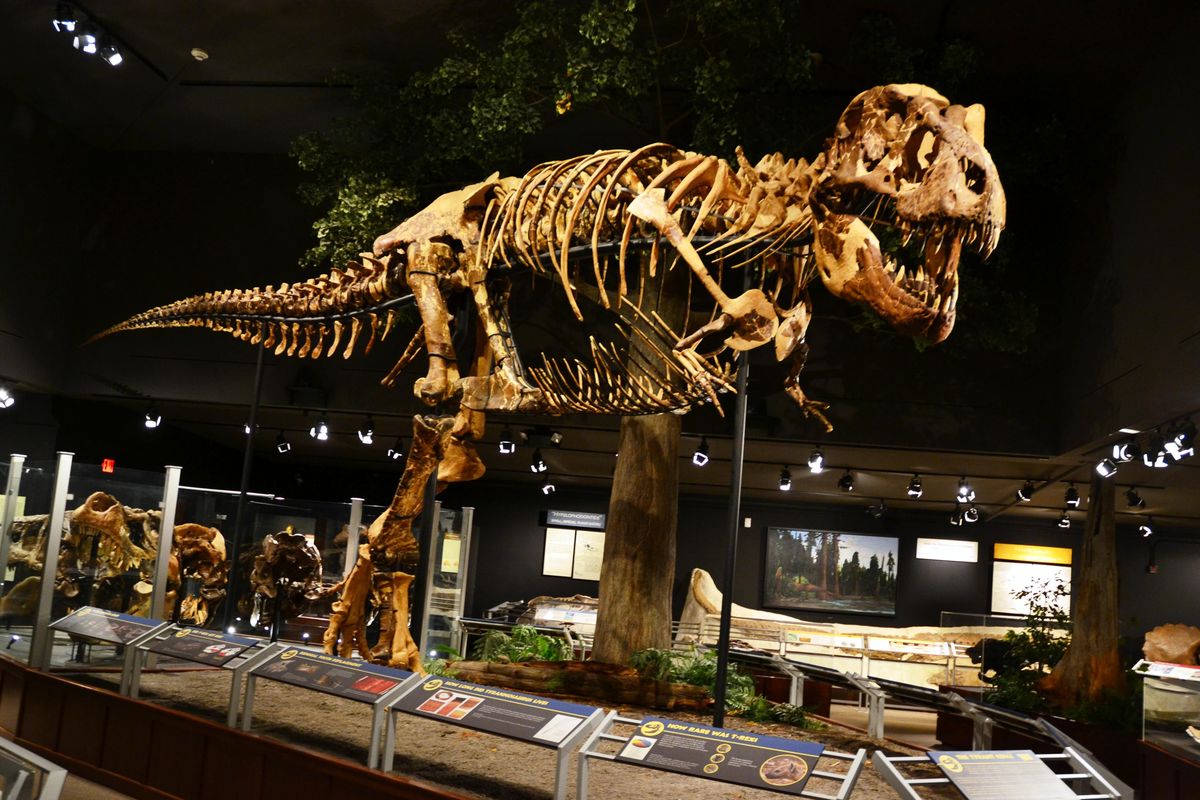Visiting the dinosaurs: Museum has a huge collection of fossils, plus exhibits on more recent Montana history

Museum of the Rockies rocks.
This Bozeman institution displays literally tons of rocks that are millions of years old – the fossilized remains of plants and animals that no longer exist. Including an incredible collection of dinosaurs.
Though dinosaurs have been gone for millions of years, they still fascinate. And they’re still very much a part of our daily lives. Think about how they have been pictured in recent years on children’s shows such as “Barney” or “The Flinstones,” in logos such as Sinclair’s green dino or in the movie “Jurassic Park.”
Seeing dinosaur bones in person is shocking. One of the most prominent displays at the museum is a Tyrannosaurus rex, which was found in Montana. At 12 feet high and about 40 feet long, it was bigger than an elephant and the teeth, you can’t miss them. They are enormous – some teeth are as big as bananas in rows on each side of the mouth. T. rexes roamed the Earth 65 million years ago, long before humans. This fossilized skeleton is one of the most complete ever found, with about 90% of the bones. (They’re the dark ones; the white are replicas to complete the display.) The museum also has the largest and smallest T. rex skulls ever found.
Another display at the museum focuses on the triceratops, which lived during the same era as T. rex and was as big as or bigger than any land animal alive today weighing 4 tons and measuring longer than 25 feet. This animal had a single horn and, unlike T. rex, was a vegetarian. How do paleontologists know this stuff? They have found skulls and bones, lots of them in Montana. T. rex skeletons are extremely rare but triceratops bones are more common. There is a display of several triceratops skulls in a row that show this animal’s growth into maturity. Among other things that scientists have learned from these bones is that they had horns (they are still attached) and their teeth look like a cow’s teeth used in grinding. Also, because of finding many more scattered bones, triceratops probably grazed in large herds.
Scientists continue to learn about dinosaurs. In the early days of discovering bones scientists didn’t have a complete skeleton to work with. So, they had to guess what the entire animal looked like. But now, with recent discoveries, scientists have found many more bones, impressions of skin, colored feathers and fossilized dinosaur eggs and nests.
Museum visitors can see some of that discovery happening at the museum. Sometimes volunteers or scientists are working on fossils at the museum.
And here is a spoiler if you visit: Scientists now believe that dinosaurs are not extinct. The large dinosaurs did die off. But they live on in the form of birds. As researchers continue studying dinosaurs using DNA testing and finding more fossils, they connected the dots of the similarities like their DNA is similar, they both lay eggs, exhibit feathers and each has hollow bones. Think about large and small but basic similarities (body type) between birds and dinosaurs.
Beyond dinosaurs
Admission to the museum is for two consecutive days. And there’s much to see.
There are exhibit rooms with information about local Native American tribes, Yellowstone National Park, ranching and homesteading, and examples of historic transportation used in the area.
William Clark’s visit to the area in July 1806 is highlighted in one exhibit. The museum displays that segment of the Lewis and Clark expedition’s journey as they carved canoes from trees and lashed them together to float down the Yellowstone River.
There’s also a planetarium with a presentation of stars and galaxies overhead.
Big names
Two individuals are forever associated with the museum.
Caroline McGill earned a doctorate and graduated from the University of Montana in 1905. She became the first pahtologist in Butte and was the first woman to study medicine at Johns Hopkins University, graduating in two years instead of the usual four. She returned to Montana to practice medicine, and over the course of her career acquired many family heirlooms and other items from patients.
She donated those items to Montana State University in 1957, and they became a core part of the Museum of the Rockies’ regional history exhibits.
John Horner, the museum’s former curator of paleontology, grew up in Montana and is known worldwide for his dinosaur finds. Because of his work, what is known about dinosaurs and dinosaur life 65 million years ago has grown exponentially. His finds of dinosaur eggs, nests, embryos, and almost complete skeletons has dramatically changed what scientists thought about how dinosaurs looked and lived. Most of the fossil specimens and displays are associated with him.